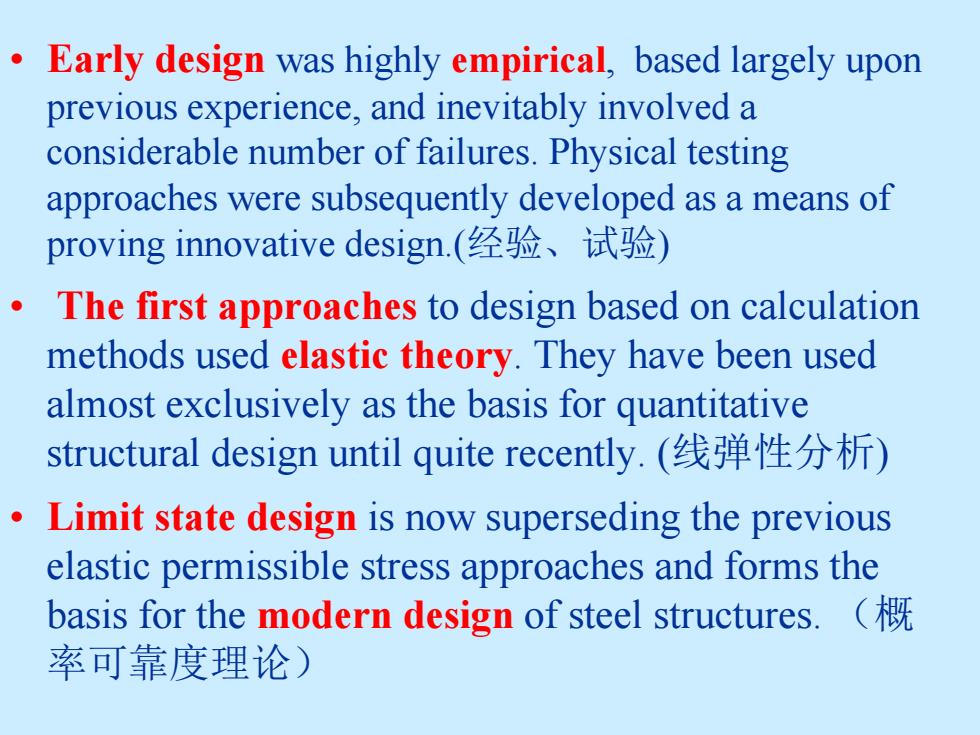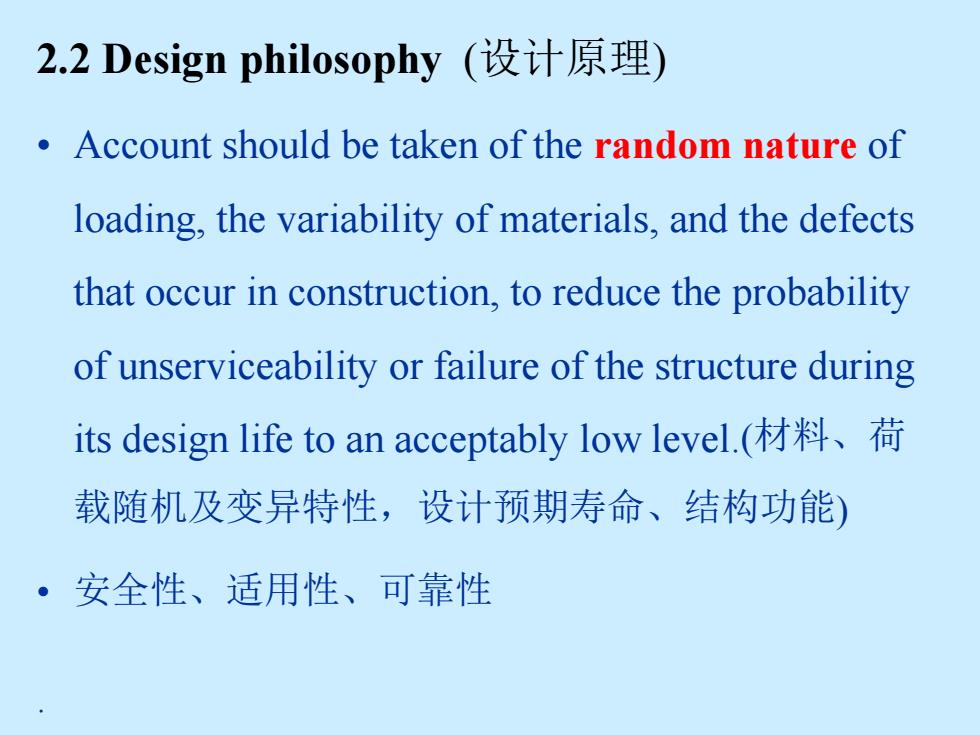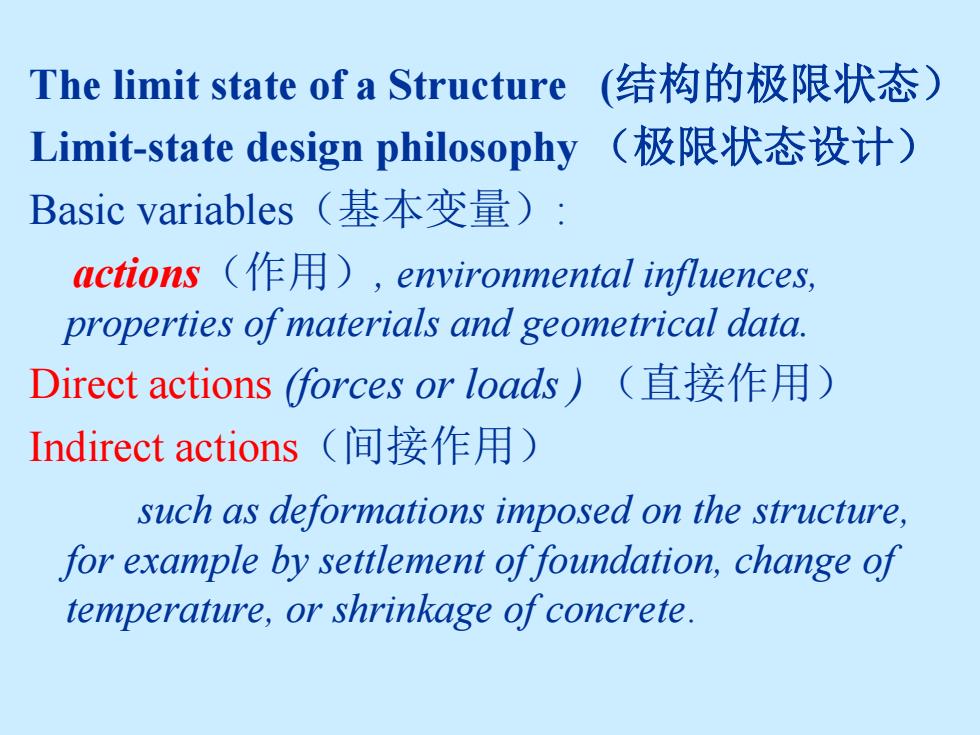
Early design was highly empirical,based largely upon previous experience,and inevitably involved a considerable number of failures.Physical testing approaches were subsequently developed as a means of proving innovative design.(经验、试验) The first approaches to design based on calculation methods used elastic theory.They have been used almost exclusively as the basis for quantitative structural design until quite recently.(线弹性分析) Limit state design is now superseding the previous elastic permissible stress approaches and forms the basis for the modern design of steel structures. 率可靠度理论)
• Early design was highly empirical, based largely upon previous experience, and inevitably involved a considerable number of failures. Physical testing approaches were subsequently developed as a means of proving innovative design.(经验、试验) • The first approaches to design based on calculation methods used elastic theory. They have been used almost exclusively as the basis for quantitative structural design until quite recently. (线弹性分析) • Limit state design is now superseding the previous elastic permissible stress approaches and forms the basis for the modern design of steel structures. (概 率可靠度理论)

2.2 Design philosophy(设计原理) Account should be taken of the random nature of loading,the variability of materials,and the defects that occur in construction,to reduce the probability of unserviceability or failure of the structure during its design life to an acceptably low level.(材料、荷 载随机及变异特性,设计预期寿命、结构功能) ·安全性、适用性、可靠性
2.2 Design philosophy (设计原理) • Account should be taken of the random nature of loading, the variability of materials, and the defects that occur in construction, to reduce the probability of unserviceability or failure of the structure during its design life to an acceptably low level.(材料、荷 载随机及变异特性,设计预期寿命、结构功能) • 安全性、适用性、可靠性

The limit state of a Structure(结构的极限状态) Limit-state design philosophy (极限状态设计) Basic variables(基本变量): actions(f作用),environmental influences, properties of materials and geometrical data. Direct actions (forces or loads)(直接作用) Indirect actions(间接作用) such as deformations imposed on the structure, for example by settlement offoundation,change of temperature,or shrinkage of concrete
The limit state of a Structure (结构的极限状态) Limit-state design philosophy (极限状态设计) Basic variables(基本变量): actions(作用), environmental influences, properties of materials and geometrical data. Direct actions (forces or loads ) (直接作用) Indirect actions(间接作用) such as deformations imposed on the structure, for example by settlement of foundation, change of temperature, or shrinkage of concrete

There are two classes of limit states: Ultimate Limit State(ULS,承载能力极限状态) relate to structural failures,whether by rupture, crushing,buckling,fatigue or overturning etc Service Limit State(SLS,正常使用极限状态) relate to serviceablity,such as excessive deformation, vibration,or width of cracks in concrete(durability )etc. 极限状态的设计表达式 1、极限状态方程的功能函数 Z=R-S=8(R,S) 2-1 Z=0,R=S,结构的极限状态方程 Z=8(R,S)=R-S=0 2-2
There are two classes of limit states: Ultimate Limit State (ULS,承载能力极限状态) – relate to structural failures, whether by rupture, crushing, buckling, fatigue or overturning etc Service Limit State (SLS,正常使用极限状态) – relate to serviceablity, such as excessive deformation, vibration, or width of cracks in concrete(durability )etc. 极限状态的设计表达式 1、极限状态方程的功能函数 Z = R-S = g( R, S ) 2-1 Z = 0 , R = S , 结构的极限状态方程 Z = g( R, S ) = R-S = 0 2-2

Three main types of action: Permanent(G or g),formerly Dead load-applied continuously during the life of the structure (such as self-weight,floor finishes,internal walls )Dead load can be determined quite accurately from the known dimensions of the structure and densities of materials. Variable (Q or q),formerly Live (or imposed)loads -essentially the 'working'loads,wind load and earthquake load as specified in the Loading Code Accidental (A)-such as impact from a vehicle and high temperature from a fire
• Three main types of action: • Permanent (G or g), formerly Dead load - applied continuously during the life of the structure (such as self-weight, floor finishes, internal walls ). Dead load can be determined quite accurately from the known dimensions of the structure and densities of materials. • Variable (Q or q), formerly Live (or imposed) loads -essentially the ‘working’ loads, wind load and earthquake load as specified in the Loading Code • Accidental (A) - such as impact from a vehicle and high temperature from a fire